Genus Camponotus subgenus Orthonotomyrmex
| The Ants of
Africa Genus Camponotus subgenus Orthonotomyrmex |
|
| Genus Camponotus |
Orthonotomyrmex Ashmead (1906: 31)
Subgenus definition - as a rule of a heavy build, with opaque integument, sometimes silky or with a few short, coarse, obtuse hairs. Head of major very broad posteriorly. Head of minor trapezoidal, broadened behind. Clypeus with or without median lobe. Pronotum variably margined; dorsum of thorax usually with metanotal groove, in the form of a notch, sometimes reduced to a deep line; propodeum margined on sides and behind, sometimes rounded. Petiole node squamiform or nodiform, summit always smooth edged.
![]() Ashmead (1905b: 34) first
named the genus Orthonotus with
its type species being Formica sericea Fabr. He renamed it Orthonotomyrmex
the next year - his statements are at
Ashmead (1905b: 34) first
named the genus Orthonotus with
its type species being Formica sericea Fabr. He renamed it Orthonotomyrmex
the next year - his statements are at ![]() . The status was reduced to a subgenus of Camponotus
by Forel (1913b: 350), who noted that this preceded the name Myrmentoma
used in his earlier list of subgenera (Forel, 1912i: 91-92)
. The status was reduced to a subgenus of Camponotus
by Forel (1913b: 350), who noted that this preceded the name Myrmentoma
used in his earlier list of subgenera (Forel, 1912i: 91-92) ![]() .
.
| 1 |  Gaster elongated without
pubescence and shiny; rest of body matt; entirely black, appendages red
brown with the scape, middle of the femora and tibiae darker brown,
trochanters reddish yellow; minor TL 4.8-5.8 mm; erect hairs brownish,
particularly long and pointed on the alitrunk and petiiole Gaster elongated without
pubescence and shiny; rest of body matt; entirely black, appendages red
brown with the scape, middle of the femora and tibiae darker brown,
trochanters reddish yellow; minor TL 4.8-5.8 mm; erect hairs brownish,
particularly long and pointed on the alitrunk and petiiole |
South Africa - liogaster |
| -- | Gaster with distinct pubescence, in some species forming a dense covering on the gaster | 2 |
| 2 | Petiole node with narrow profile | 3 |
| -- | Petiiole node thick and domed | 4 |
| 3 | 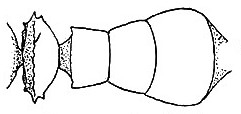 Petiole node wider than propodeum and defined dentate
posterior dorsal margin;
TL 4.6-6.0 mm; sparse erect pilosity greyish and fairly short;
generally reticulo-punctate; wider on head and pronotum than other
species, finer on gaster and femurs, giving dull appearance; black,
tibiae, tarsi & antennae ferruginous, mandibles castaneous, inner
edges piceous (Arnold drawing misleading) Petiole node wider than propodeum and defined dentate
posterior dorsal margin;
TL 4.6-6.0 mm; sparse erect pilosity greyish and fairly short;
generally reticulo-punctate; wider on head and pronotum than other
species, finer on gaster and femurs, giving dull appearance; black,
tibiae, tarsi & antennae ferruginous, mandibles castaneous, inner
edges piceous (Arnold drawing misleading) |
. |
| . |  |
Zimbabwe - scabrinodis |
| -- | 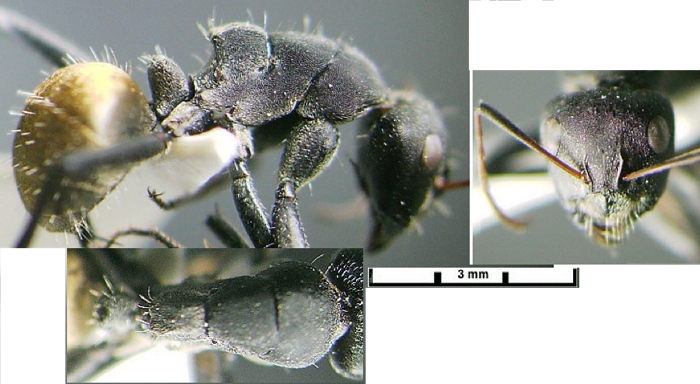 Petiole
node with smooth edges but
emarginate; TL 8-10 mm Petiole
node with smooth edges but
emarginate; TL 8-10 mm |
Sahara, Egypt and eastwards into South Asia - obtusus |
| 4 | Pubescence golden and shiny, variably dense on gaster | 5 |
| -- | Pubescence greyish white | 6 |
| 5 | 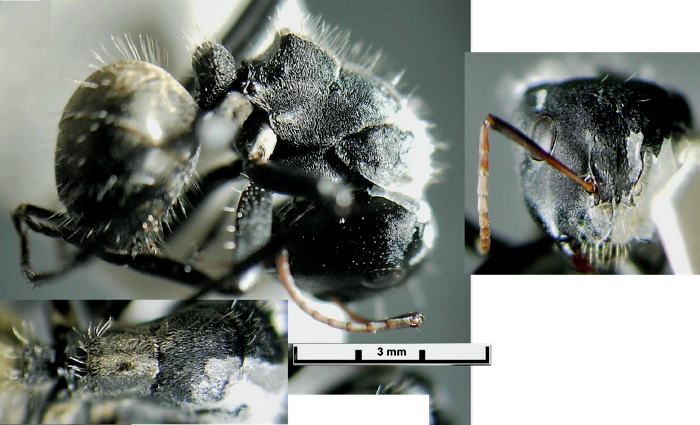 Pubescence golden and
shiny, dense on gaster; major TL
8-10 mm; basically unicolorous Pubescence golden and
shiny, dense on gaster; major TL
8-10 mm; basically unicolorous |
West Africa and Congo Basin, Sudan, Zimbabwe - sericeus |
| -- | 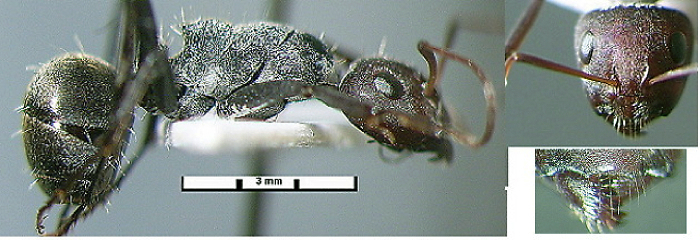 Head, alitrunk and
appendages red often quite bright; more
slender; petiole scale higher; gaster black; pubescence greyish yellow;
the clypeus is quite distinct from that of sericeus, in having no
median carina but with the anterior margin with the median part concave
and quite prominent denticles between the median arc and the lateral
arcuate sectors Head, alitrunk and
appendages red often quite bright; more
slender; petiole scale higher; gaster black; pubescence greyish yellow;
the clypeus is quite distinct from that of sericeus, in having no
median carina but with the anterior margin with the median part concave
and quite prominent denticles between the median arc and the lateral
arcuate sectors |
Western Sahel - euchrous |
| 6 | Propodeum profile distinctly domed, convex both longitudinally and transversely | 7 |
| -- | Propodeum dorsum flat or nearly so; pubescence sparse | 8 |
| 7 | 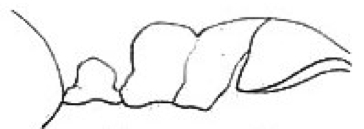 Pubescence
greyish-white and dense all over; black,
mandibles and tarsi dark reddish brown; major TL 9-10.2 mm Pubescence
greyish-white and dense all over; black,
mandibles and tarsi dark reddish brown; major TL 9-10.2 mm |
. |
| . | 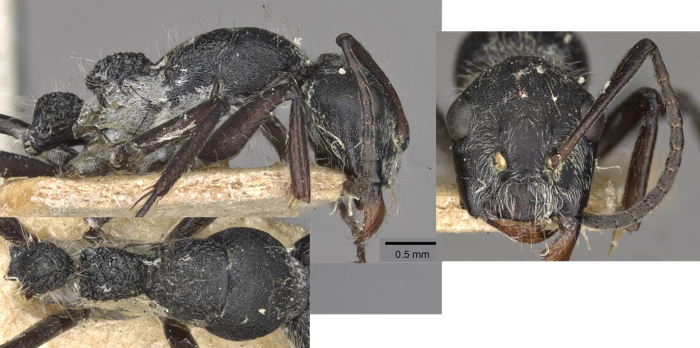 Minor Minor |
Angola & South Africa - cubangensis |
| -- | 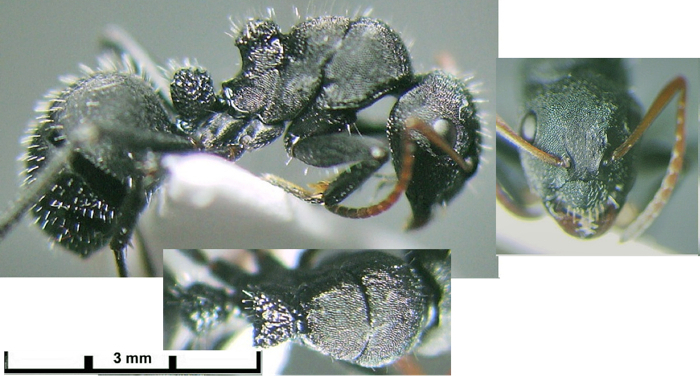 Pubescence
extremely sparse; propodeum and
petiole with very distinctive "cobbled" sculpturation; major TL ca 7.0
mm Pubescence
extremely sparse; propodeum and
petiole with very distinctive "cobbled" sculpturation; major TL ca 7.0
mm |
South Africa - new species RSA |
| 8 | 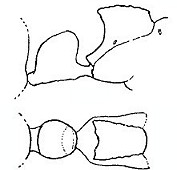 Mesonotum strongly narrowed posteriorly; petiole profile a
forward tilted dome; major TL 9-10 mm; with large but shallow pits
superimposed on the fundamental reticulate-punctate sculpture of the
propodeum and petiole node; sides of propodeum coarsely rugose Mesonotum strongly narrowed posteriorly; petiole profile a
forward tilted dome; major TL 9-10 mm; with large but shallow pits
superimposed on the fundamental reticulate-punctate sculpture of the
propodeum and petiole node; sides of propodeum coarsely rugose |
. |
| . | 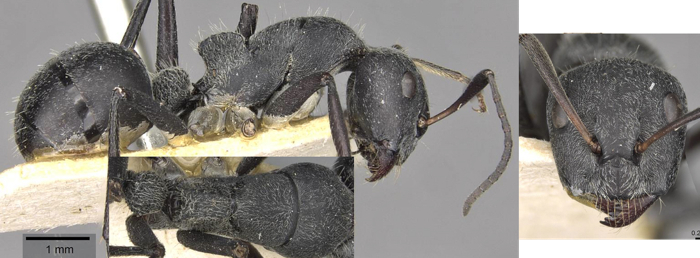 Minor (type) Minor (type) |
|
| . | 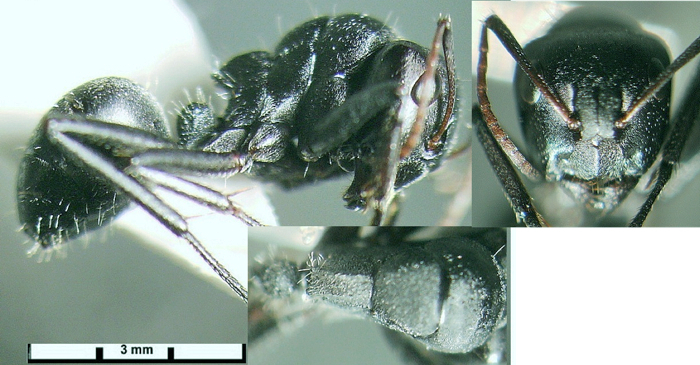 |
Gabon, Angola & South Africa - mayri |
| -- | 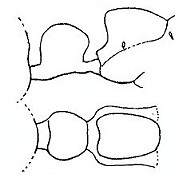 Mesonotum not strongly narrowed posteriorly, petiole
profile a rounded dome; without any large but shallow pits superimposed
on the fundamental reticulate-punctate sculpture of the propodeum and
petiole node; major TL 10.5 mm Mesonotum not strongly narrowed posteriorly, petiole
profile a rounded dome; without any large but shallow pits superimposed
on the fundamental reticulate-punctate sculpture of the propodeum and
petiole node; major TL 10.5 mm |
. |
| . |  Major Major |
. |
| . |  Minors 8.2-8.7 mm Minors 8.2-8.7 mm |
Congo Basin, east into northern Zambia - sankisianus |
| Genus page |
© 2007, 2008, 2009, 2013, 2014, 2018 - Brian Taylor CBiol
FRSB FRES 11, Grazingfield, Wilford, Nottingham, NG11 7FN, U.K. |
href="orthonotomyrmex.htm"